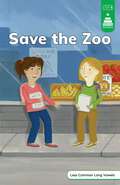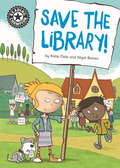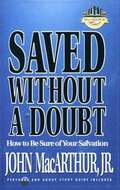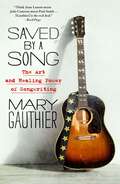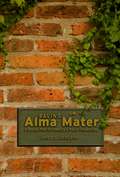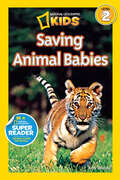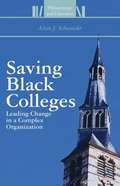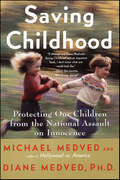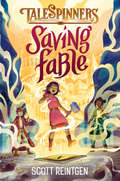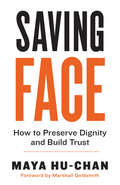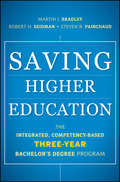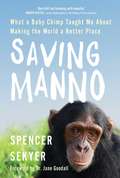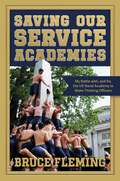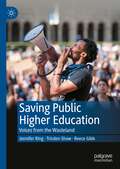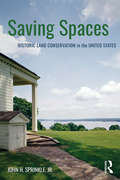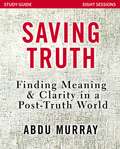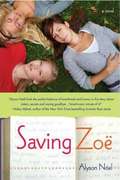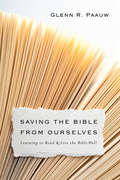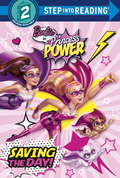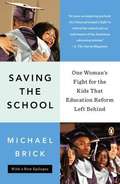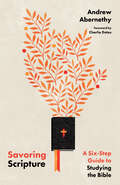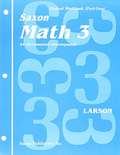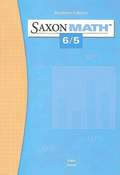- Table View
- List View
Save the Zoo (Stairway Decodables Step 6)
by Leanna KochWhen Annie and Lottie visit the neighborhood zoo for a class trip, they are disappointed to discover the zoo might close. With a town vote approaching, the girls worked to convince people to spend the town’s money to fix up the zoo. Will their efforts pay off to keep the zoo open? Stairway Decodables is a supplemental phonics resource that’s perfect for supporting small group instruction, independent reading, or reading practice at home. This title provides practice in decoding words with the vowel combinations eigh, ie, ei.
Save the library!: Independent Reading 12 (Reading Champion #257)
by Katie DaleSummer is distraught when she finds her local library is going to close! She can't let that happen, so she sets about rallying friends to stop the closure and save the library.Reading Champion offers independent reading books for children to practise and reinforce their developing reading skills.Fantastic, original stories are accompanied by engaging artwork and a reading activity. Each book has been carefully graded so that it can be matched to a child's reading ability, encouraging reading for pleasure. The Key Stage 2 Reading Champion Books are suggested for use as follows:Independent Reading 11: start of Year 3 or age 7+Independent Reading 12: end of Year 3 or age 7+Independent Reading 13: start of Year 4 or age 8+Independent Reading 14: end of Year 4 or age 8+Independent Reading 15: start of Year 5 or age 9+Independent Reading 16: end of Year 5 or age 9+Independent Reading 17: start of Year 6 or age 10+Independent Reading 18: end of Year 6 or age 10+
Saved Without a Doubt
by John F. MacarthurJohn MacArthur demonstrates how a person can know whether they are truly saved. He presents 11 biblical tests to determine whether salvation has been experienced. Includes personal and group study guide.
Saved by a Song: The Art and Healing Power of Songwriting
by Mary Gauthier"A handbook for compassion... a Must-Read Music Book.”—Rolling Stone Country"Generous and big-hearted, Gauthier has stories to tell and worthwhile advice to share." —Wally Lamb, author of I Know This Much Is True"Gauthier has an uncanny ability to combine songwriting craft with a seeker’s vulnerability and a sage’s wisdom.” —Amy Ray, Indigo GirlsFrom the Grammy nominated folk singer and songwriter, an inspiring exploration of creativity and the redemptive power of song Mary Gauthier was twelve years old when she was given her Aunt Jenny’s old guitar and taught herself to play with a Mel Bay basic guitar workbook. Music offered her a window to a world where others felt the way she did. Songs became lifelines to her, and she longed to write her own, one day. Then, for a decade, while struggling with addiction, Gauthier put her dream away and her call to songwriting faded. It wasn’t until she got sober and went to an open mic with a friend did she realize that she not only still wanted to write songs, she needed to. Today, Gauthier is a decorated musical artist, with numerous awards and recognition for her songwriting, including a Grammy nomination. In Saved by a Song, Mary Gauthier pulls the curtain back on the artistry of songwriting. Part memoir, part philosophy of art, part nuts and bolts of songwriting, her book celebrates the redemptive power of song to inspire and bring seemingly different kinds of people together.
Saving Alma Mater: A Rescue Plan for America's Public Universities
by James C. GarlandAmerica's public universities educate 80% of our nation's college students. But in the wake of rising demands on state treasuries, changing demographics, growing income inequality, and legislative indifference, many of these institutions have fallen into decline. Tuition costs have skyrocketed, class sizes have gone up, the number of courses offered has gone down, and the overall quality of education has decreased significantly.Here James C. Garland draws on more than thirty years of experience as a professor, administrator, and university president to argue that a new compact between state government and public universities is needed to make these schools more affordable and financially secure. Saving Alma Mater challenges a change-resistant culture in academia that places too low a premium on efficiency and productivity. Seeing a crisis of campus leadership, Garland takes state legislators to task for perpetuating the decay of their public university systems and calls for reforms in the way university presidents and governing boards are selected. He concludes that the era is long past when state appropriations can enable public universities to keep their fees low and affordable. Saving Alma Mater thus calls for the partial deregulation of public universities and a phase-out of their state appropriations. Garland's plan would tie university revenues to their performance and exploit the competitive pressures of the academic marketplace to control costs, rein in tuition, and make schools more responsive to student needs.A much-needed blueprint for reform based on Garland's real-life successes as the head of Miami University of Ohio, Saving Alma Mater will be essential for anyone concerned with the costs and quality of higher education in America today.
Saving Animal Babies (National Geographic Kids Readers)
by Amy ShieldsThese heartwarming stories of animal babies, rescued and nursed back to health by humans, will pull at the heart strings and make kids realize there's a survivor inside all of us. This reader is illustrated with adorable photographs that document these animals' recoveries. The carefully written text guarantees a successful and rewarding reading experience for level 1 readers.National Geographic supports K-12 educators with ELA Common Core Resources.Visit www.natgeoed.org/commoncore for more information.
Saving Black Colleges
by Alvin J. SchexniderSaving Black Colleges makes clear the challenges, opportunities, and prospects for change historically black colleges and universities now face. Schexnider, the former chancellor of Winston-Salem State University, details what he could and could not accomplish, examines how these issues affect other HBCUs, and outlines a practical way forward. Alvin J. Schexnider is the president of Schexnider & Associates, LLC. He previously served as the president of Thomas Nelson Community College and as the executive vice president and interim president of Norfolk State University.
Saving Childhood: Protecting Our Children from the National Assault on Innocence
by Michael Medved Diane MedvedSaving Childhood offers parents and grandparents practical strategies to cope with a society that seems perversely determined to frighten and corrupt its young. Cultural critic and popular radio host Michael Medved and his wife, psychologist Diane Medved, argue that in a mistaken effort to curb problems plaguing its youth, our culture has changed from protecting childhood as a precious time of growth to hammering even the smallest youngsters with a grim, harsh, and menacing view of the world. The Medveds systematically present unassailable scientific evidence, moving anecdotes, and personal experiences of raising their three young children to explain the attack from four primary directions--media, schools, peers, and even well-intentioned parents themselves.In a unique analysis the Medveds define innocence not as ignorance but as the result of three components--security, a sense of wonder and optimism. They empower parents and all who care about childhood with concrete, easily accomplished means to fend off the assault, as well as advice for handling hurdles such as the Internet, television, peer pressure, and the plague of pessimism. Saving Childhood enables us to restore and maintain for our children imagination, confidence, and hope for the future.
Saving Fable: Saving Fable (Talespinners #1)
by Scott ReintgenSide characters can be heroes too in this charming and fast-paced adventure that is The Land of Stories meets The Phantom Tollbooth!Indira has been a character-in-waiting her entire life. So she can't believe her luck when she's finally chosen to travel to Fable and study at the renowned Protagonist Preparatory, a school known for producing the best heroes. <p><p> But Indira's dreams of achieving hero status don't exactly go as planned. A failed audition lands her in the school's side-character track, and her best efforts to prove advisors--famous characters like Alice from Wonderland and Professor Darcy--wrong are constantly sabotaged. Indira is starting to feel like an evil antagonist might be to blame. <p> As the danger spreads, Indira discovers all of Fable is under siege. With her friends Maxi and Phoenix by her side, she pieces together clues that will reveal who is behind the dark magic threatening them all. But the more Indira uncovers, the more doubt she feels about her place in this world of stories. After all, can a side character really save the day?
Saving Face: How to Preserve Dignity and Build Trust
by Maya Hu-Chan"Maya Hu-Chan shares a blueprint for becoming a more empathetic, self-aware, and inclusive leader. Saving Face guides us to consider different perspectives, to think first and speak last, and to respect others above all else."—Frances Hesselbein, former CEO, Girl Scouts of the USA, and Presidential Medal of Freedom recipientOrganizations now need to attract, retain, and motivate teams and employees across distance, time zones, and cultural differences. Building authentic and lasting human relations may be the most important calling for leaders in this century. According to management and global leadership specialist Maya Hu-Chan, the concept of "saving face" can help any leader preserve dignity and create more empathetic cross-cultural relationships. "Face" represents one's self-esteem, self-worth, identity, reputation, status, pride, and dignity. Saving face is often understood as saving someone from embarrassment, but it's also about developing an understanding of the background and motivations of others to discover the unique facets we all possess. Without that understanding, we risk causing others to lose face without even knowing it. Hu-Chan explains saving face through anecdotes and practical tools, such as her BUILD leadership model (Benevolence, Understanding, Interacting, Learning, and Delivery). This book illustrates how we can give face to create positive first impressions, avoid causing others to lose face, and, most importantly, build trust and lasting relationships inside and outside the workplace.
Saving Higher Education
by Martin J. Bradley Robert H. Seidman Steven R. PainchaudColleges and universities are under pressure from the government, students, and parents to make higher education more efficient and cost-effective. Based on Southern New Hampshire University's highly successful competency-based three-year bachelors degree program-the longest running in the country-this book provides a blueprint for creating, sustaining, and growing such a program at an institution of any type and size. The book offers a proven model that not only cuts student costs by 25%, but significantly reduces program delivery costs. The 120-credit six-semester competency-based integrated curriculum approach focuses on student learning as opposed to "seat-time," and research shows above average academic student success.
Saving Manno: What a Baby Chimp Taught Me About Making the World a Better Place
by Spencer SekyerAn inspiring and uplifting memoir about one small-town teacher’s eye-opening travels around the world and his relentless efforts to rescue a chimp in danger.As a child, Spencer Sekyer’s world was a simple one. He grew up in a small town, where many of his days were spent hunting in the woods and pursuing his dream of becoming a professional athlete. But when his athletic career ended, he found himself seeking new goals. Spencer returned to school and became a teacher. Realizing he still had much to learn about the world, Spencer set out to explore its most dangerous areas. He traveled to Sierra Leone to volunteer in a local school, followed by trips to the West Bank, Afghanistan, and Haiti. Each time, Spencer returned home a little wiser, a little more emotionally mature, and a little more ready to give back to a world that had given him so much. In Duhok, Kurdistan, Spencer’s journey took a new turn. After stumbling into a local zoo, Spencer formed an unlikely bond with Manno, a young chimpanzee who had been kidnapped from his family in central Africa and sold into captivity. Determined to get Manno back to his home, Spencer began to investigate the shadowy, dangerous world of global animal trafficking. Facing resistance at every turn, and with ISIS closing in on Duhok, Spencer finally set in motion an international effort to get his friend to safety, before it was too late. Bursting with compassion, inspiration, and courage, Saving Manno is a testament to the fact that every one of us has the power to change lives and make the world a better place.
Saving Our Service Academies: My Battle with, and for, the US Naval Academy to Make Thinking Officers
by Bruce FlemingOnce proud citadels of virtue, the US military academies have lost their way and are running on fumes. They need to be fixed before it&’s too late.Saving Our Service Academies covers one man&’s unrelenting thirty-year fight with the military bureaucracy to instill qualities of force and thoughtfulness in officers-to-be, to show young men how to be adults with other men and women, and to show young women how to deal with the men. Bruce Fleming has spent over thirty years teaching midshipmen and future officers at the US Naval Academy in Annapolis. This position was both a dream job and a nightmare for the enthusiastic, athletic, young Fleming. He found, in the thousands of midshipmen he taught, mentored, and exercised with for three decades, a heartbreaking waste of potential, as promising officers-to-be lapsed into apathy and cynicism because of the dispiriting reality behind the gleaming facade of the Naval Academy. What happened to duty, honor, and country at Annapolis? These values have disappeared in the wake of changes in the world, such as the rise of ROTC and the increase in expense of civilian colleges (the service academies are free to the students), and in the attempt to use the service academies as experiments in trendy social engineering. A staunch advocate for military strength, Fleming shows how the smoke and mirrors of service academies produce officers who are taught to say &“SIR, YES SIR&” rather than to have the guts to say things their commanding officer doesn&’t want to hear. Is that why the US hasn&’t won a war since World War II? By writing op-eds about the waste, fraud, and abuse of government (and taxpayer) money, Fleming put a target on his back that the USNA administration used to fire him in 2018, despite being a tenured civilian professor. He was reinstated by a federal judge in 2019. The service academies are government programs that no longer fill the needs for which they were created, and so like all government programs, can be re-examined. Indeed, as Fleming argues, they teach blind obedience in officers rather than informed and respectful questioning, and so sap our military strength rather than increasing it. They need to be re-imagined not as stand-alone undergraduate institutions that wall off future officers in an increasingly untenable isolation from the country they are to defend, but either be combined with the officer commissioning sources that currently produce over 80 percent of our new officers, or re-purposed to post-civilian college training institutions.
Saving Our Students, Saving Our Schools: 50 Proven Strategies for Helping Underachieving Students and Improving Schools
by Robert Dale Barr William H. ParrettThis field-tested resource outlines effective approaches for improving student learning, proficiency, and achievement at all levels through learning-focused priorities, results-driven practices, and high academic expectations.
Saving Public Higher Education: Voices from the Wasteland
by Jennifer Ring Trisden Shaw Reece GibbIn this book, eleven recent college graduates describe in vivid detail their journeys from racially segregated, underfunded public schools to a state university, and the obstacles they encountered along the way. Chapters highlight personal accounts of poverty, violence, and bullying in childhood, the persistence of racism on the university campus and the inability of faculty and administrators to combat it. Overcoming all-too-common barriers, these eleven students persevered, earned their degrees and continued on to graduate school and professional careers. The authors conclude the book with policy proposals that not only address the issues raised by the students, but that would also restore public education to its original role as an engine of opportunity and driver of democracy.
Saving Science Class: Why We Need Hands-on Science to Engage Kids, Inspire Curiosity, and Improve Education
by Christopher McgowanMuch of what our students are learning about science in school bears little resemblance to real science. That is the main theme of this critique of science education by a veteran scientist and former school teacher. The author charges that today's teaching mandate has been taken over by educational specialists, people with little or no understanding of science. They clutter curricula with extraneous material, like engineering and technology, and focus so much attention theorizing over hypotheses and models and categorizing everything, that no time remains for doing science. There is little to entice youngsters to the science classroom today. McGowan emphasizes that the problem is not the teachers but the materials they are obliged to teach. He is especially critical of the widely influential "Next Generation Science Standards" (NGSS). This is based upon "A Framework for K-12 Science Education," which has been inordinately influenced by educational specialists. This is evident from the esoteric language, the almost exclusive citation of educational publications, and by glaring errors in science. The author urges a rethinking of science education to bring the focus back to conducting real hands-on science in the classroom. This approach was pioneered by the Nuffield Science Teaching Project in the UK, where working scientists acted as resource personnel for teachers designing curricula. Given the catastrophic problems facing planet Earth, scientific literacy has never been more important.From the Hardcover edition.
Saving Spaces: Historic Land Conservation in the United States
by John H. Sprinkle, Jr.Saving Spaces offers an historical overview of the struggle to conserve both individual parcels of land and entire landscapes from destruction in the United States. John Sprinkle, Jr. identifies the ways in which the identification, evaluation, and stewardship of selected buildings and landscapes reflect contemporary American cultural values. Detailed case studies bring the text to life, highlighting various conservation strategies and suggesting the opportunities, challenges, and consequences of each. Balancing close analyses with a broader introduction to some of the key issues of the field, Saving Spaces is ideal for students and instructors of historic preservation.
Saving Truth Study Guide: Finding Meaning and Clarity in a Post-Truth World
by Abdu MurrayHow Christians can guard their own minds against the lies that surround us and defend truth and clarity to a world that rejects both.By accurately describing the Culture of Confusion, the rise of the "post-truth" mindset, and how it has affected our society, author Abdu Murray will awaken you and your group to the plight we find ourselves in and challenge Christians to steer away from contributing to such a culture by instead finding hope in the clarity that Christ offers.In this eight-session, video-based study (DVD/streaming video sold separately) is designed to take you deeper into the topic of meaning and clarity through personal reflection and Scripture engagement and will:Help you understand the post-truth mindset and how it infects and affects us all.Equip you with facts and knowledge about the various areas of life where we are steeped in a post-truth mindset and losing our bearings as a culture, specifically: our freedom, our humanity, our sexuality, faith and science, and religious pluralism.Explain how the message of Jesus can answer our deepest questions, and how the actions of Jesus can bring truth and clarity to a post-truth culture desperately in need of objective, biblical truth. Increasingly, Western culture embraces confusion as a virtue and decries certainty as a sin. Those who are confused about morality are progressive pioneers. Those who are confused about spirituality are praised as tolerant. And those who express certainty about any of these issues are seen as bigoted, oppressive, or intolerant.For individuals or groups who feel like they're enmeshed in the culture of confusion, the Saving Truth Study Guide sheds light on the way to see through the fog that surrounds us—by seeing Jesus and his message as the fixed point of reference that we so desperately need.Saving Truth Video Study (9780310590026) sold separately.
Saving Zoë
by Alyson NoëlIn Alyson Noël's newest teen novel, one sister's secrets save the other's life in more ways than one. Meet fifteen-year-old Echo, a typical teen trying to survive high school without being totally traumatized by boy trouble, friend drama, and school issues. As if she didn't have enough on her plate, Echo is also still dealing with the murder of her sister Zoë. Although it's been over a year, Echo is still reeling from tragedy that changed everything. Beautiful and full of life, Zoë was the glue that held her family together, and although the two sisters were as different as night and day, they still had a bond that Echo can't let go of. When Zoë's old boyfriend Marc shows up one day with Zoë's diary, Echo doesn't think there's anything in there she doesn't already know. But as she gives in to curiosity and starts reading, she learns that her sister led a secret life that no one could have guessed not even Echo.
Saving the Bible from Ourselves: Learning to Read and Live the Bible Well
by Glenn R. PaauwECPA 2017 Christian Book Award Finalist Does the Bible need to be saved? Over the course of the centuries, Bible scholars and publishers have increasingly added "helps"—chapter divisions, verses, subheads, notes—to the Bible in an effort to make it easier to study and understand. In the process, however, these have led to sampling Scripture rather than reading deeply. According to author Glenn R. Paauw, the text has become divorced from the Bible's literary and historical context, leading to misinterpretation and a "narrow, individualistic and escapist view of salvation." Rather than being a culture-shaping force, the Bible has become a database of quick and easy answers to life's troubling questions. But these deficiencies can be corrected by engaging in what the author calls "big readings." In these pages Paauw introduces us to seven new (to us) understandings of the Bible as steps on the path to recovering one deeply engaged Bible. With each "new" Bible presented, deficiencies in how we currently interact with the Bible are explored, followed by recommendations for a new practice. The Bible's transformative power is recovered when we remove the chains Christians have applied to it over the centuries. The Bible does not need to be saved because of any defect in itself, but because we have distorted and misread it. Saving the Bible from Ourselves provides students of the Bible a new paradigm for reading and living the Bible well.
Saving the Day! (Barbie in Princess Power)
by Melissa LagonegroGirls ages 4 to 6 will love this Step 2 Deluxe Step into Reading Reader based on Barbie's latest film, releasing in spring 2015. This book features a sparkly cover and over 30 shimmery stickers!Step 2 Readers use basic vocabulary and short sentences to tell simple stories. For children who recognize familiar words and can sound out new words with help.
Saving the School
by Michael BrickIn the race to save a failing public high school, one principal finds that making the numbers is only the beginning Being principal of Reagan High in Austin, Texas, was no dream assignment. Test scores were low, dropout rates were high, and poverty was endemic. But when Anabel Garza took the job, she started something no one expected. Racing against a deadline just to make the numbers, she set out to rebuild the kind of school that once unified neighborhoods across America. By her side, a basketball coach showed kids they could be winners, a young science teacher showed them they could learn, and a community rallied around a treasured institution. In this powerful rejoinder to the prevailing winds of education policy, Michael Brick takes readers inside the high-pressure world of a school on the brink. Paying overdue tribute to a vital American tradition—the great American high school—Saving the School exposes the flaws of a broken system but also tells an inspiring story of faith, hope, and perseverance. .
Savoring Scripture: A Six-Step Guide to Studying the Bible
by Andrew AbernethySome books on how to read the Bible are academically informative, but their rationality can make God seem distant.andPostureFlowContextWhole BibleSavor GodFaithful responseChapters provide guidance on interpreting biblical genres, factoring in historical backgrounds, reading each passage in context, tracing the redemptive storyline of Scripture, and more. Then, building on a strong grasp of Scripture's meaning, readers engage the traditional practice of lectio divina and consider how to respond faithfully to the text. The goal, Abernethy says, is to encounter God and to be shaped by the Word as we savor its richness.Savoring Scripture
Saxon Math 3 - An Incremental Development - Student Workbook (Part One)
by Nancy LarsonSaxon Math 3 - An Incremental Development - Student Workbook (Part One)
Saxon Math 6/5
by Stephen Hake John SaxonThis book is made up of daily lessons and investigations. Each lesson has four parts. The first part is a Warm-Up that includes practice of basic facts and mental math. The second part of the lesson introduces a new mathematical concept and presents examples that use the concept. Third one, the Lesson Practice helps solve problems involving the new concept. The final part is the Mixed Practice which reviews previously taught concepts and solving the problems set gives much benefit to students.
